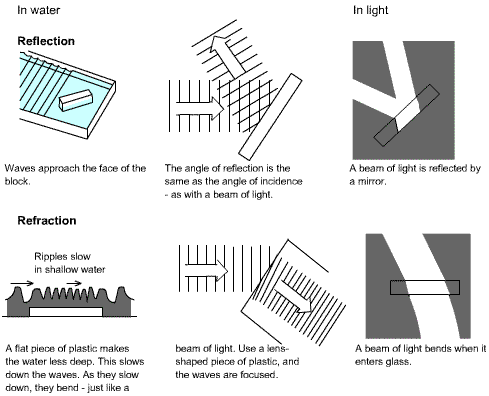Characteristics of Waves
Longitudinal and transverse waves
Waves transfer energy from one place to another but do not transfer any matter.
Waves can be produced in ropes and springs and along the surface of water.
All these waves can be reflected, they bounce off surfaces.
The waves which travel across the surface of water can also be refracted.
As the waves cross the boundary between two different depths of water they change speed. This causes a change in their direction (refraction), unless the direction of travel of the waves is along a normal, i.e. at right angles to the boundary.
A ripple tank can be used to study how waves behave.

There are two main types of wave, longitudinal and transverse.
In longitudinal waves the disturbances travel backwards and forwards in the same direction as the wave is travelling.
Sound waves and waves which travel through a spring are longitudinal.
In transverse waves the disturbances are at right angles to the direction of the wave.
Light waves, waves that travel along ropes and waves across the surface of water, are transverse.

Describing waves
When waves travel along ropes or springs or across the surface of water they set up regular patterns of disturbances.
The maximum disturbance, or height of a wave, is called its amplitude. Notice on the diagram that this is the distance from the midline of a wave to the top of a crest or to the bottom of a trough.
The distance from a particular point on one wave, to the same point on the next is called the wavelength. This can be represented by the symbol ![]() .
.
Wavelength is measured in metres.
The number of waves passing every second is called its frequency, f.
Frequency is measured in units called hertz (Hz).

The faster a wave is travelling the higher its frequency but the shorter its wavelength.
Wave speed, wavelength and frequency are related in the following equation:
wave speed = frequency x wavelength
(m/s) (Hz) (m)
or v = f ![]()
Light waves
Light waves are transverse waves and can travel across a vacuum. They do not need particles to travel. This is why light can travel across space.
They form part of the electromagnetic spectrum and travel very fast. About 300,000,000 m/s.
When light is reflected from a shiny surface the angle at which it meets the mirror (angle of incidence) is the same as the angle at which it leaves it (angle of reflection).
Rays of light change direction (are refracted) when they cross the boundary between one transparent substance and another. This is because they change speed.
As light travels from air into a more dense substance, such as glass, Perspex or water, it slows down and is refracted towards the normal.
If it is travelling in the opposite direction it speeds up and is refracted away from the normal.
If the light is travelling along normal its speed still changes, but it is not refracted.
Total internal reflection
When light travels from glass, Perspex or water into air some of the light is reflected from the boundary, whilst the rest is refracted.
If the angle of incidence is greater than a certain size, called the critical angle, all of the light is reflected within the substance and none passes out through the surface.
This is called total internal reflection.

Total internal reflection is made use of in optical fibres and periscopes.
When light travels down an optical fibre, all the light stays inside until it reaches the other end.
This is because light travels down the fibre by repeated total internal reflection.
Optical fibres are used to see inside the body, to see down drains and into cavity walls, and in telephone cables.

Sound waves
Sound waves are longitudinal waves which travel through solids, liquids and gases.
They cannot travel through a vacuum because they need particles to vibrate.
Sound travels much slower than light.
The speed of sound in air is about 330 m/s.
Sound waves travel faster in liquids than gases, and fastest of all through solids.
Diffraction
Diffraction happens when waves move through a gap or around an obstacle.
The shape of their wavefront changes so they spread out from the edges.
Their speed and wavelength do not change.
Waves that have a longer wavelength are diffracted more strongly.
It is because of diffraction that sounds can sometimes be heard around corners and in the shadow of buildings.
It is also why radio signals, particularly those with a long wavelength, can be received in the shadow of hills.

Because light and sound can be reflected, refracted and diffracted, just like waves that we can see, this supports the idea that they travel as waves.
Document Actions

 Like us on Facebook
Like us on Facebook